Blue Jays: Worst trades in franchise history

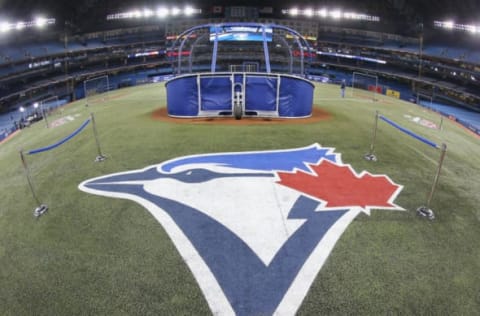
The Toronto Blue Jays have made a plethora of trades that have panned out since the team’s inception in 1977, however, here are some that did not necessarily work out in the Blue Jays favour.
The Blue Jays have acquired the likes of Jose Bautista, Josh Donaldson, and Roberto Alomar all via the trade route. Those are definitely just a few examples of some significant deals that worked out for the Blue Jays brain trust.
Being traded is not always the easiest thing for a player to swallow, especially, if your the player leaving the contending team. Former MLB catcher Joe Garagiola compared being traded to a birthday celebration.
“Being traded is like celebrating your 100th birthday. It might not be the happiest occasion in the world, but consider the alternative?”
So for the purpose of this article, we are going to armchair quarterback some not so pretty trades that have occurred throughout Blue Jays history. These trades are in no particular order and have been submitted by Jays Journal contributors.
More Articles About Blue Jays Trade History:
manual

January 25th, 2011: Blue Jays trade Mike Napoli for Frank Francisco
The Mike Napoli trade may not be the absolute worst trade the Toronto Blue Jays have ever made but boy was it a stinker.
Let’s take a trip back to 2011 where the Blue Jays offloaded Vernon Wells to the Anaheim Angels for Napoli and outfielder Juan Rivera. The Blue Jays decided to keep Rivera on board but then almost immediately sent Napoli to the Texas Rangers for Frank Francisco.
This came across as a curious move to most Blue Jays fans, I mean sure Napoli at the time may not have been viewed as a starter, but he could have added some much-needed depth behind J.P. Arencibia as well as first basemen Adam Lind. There was even an option to put Napoli in the DH role, seeing that it was pretty open with Lind moving to first.
Needless to say, this wasn’t the smartest move during the Alex Anthopoulos era. Francisco only lasted a season in Toronto, because the Blue Jays were only able to sign him to a one-year contract. He pitched an astounding 3.76 ERA in 54 appearances for the Jays, as well as managing to save 17 games.
Napoli, on the other hand, became a franchise catcher for the Rangers. Having a career slash line of .246/.346/.475 well surpassing either Arencibia or Lind. Furthermore, Napoli’s best season came in the year that Toronto received him and then gave him away. He hit .320/.414/631 with 30 home runs and 75 RBI’s and earning a WAR of 5.5.
In the later seasons, Napoli was instrumental in Texas’ 2011 World Series attempt as well as the Boston Red Sox World Series victory in 2013.
And Francisco? He re-signed with Toronto in 2014 under a minor-league deal but was eventually released.
Jays Journal Contributor: Josh Giles
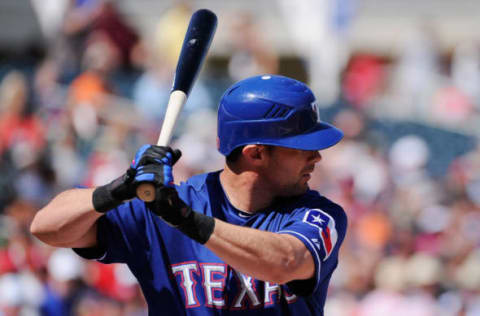
July 19th, 2000: Blue Jays trade Michael Young and Darwin Cubillan for Esteban Loaiza
The Toronto Blue Jays selected Michael Young in the 5th round of the 1997 MLB amateur draft, however, the perennial All-Star would never suit up for the Blue Jays at the major league level. Young would climb to Double-A in the Blue Jays organization before being traded to the lone star state.
Young along with Darwin Cubillan would be moved to the Texas Rangers for pitcher Esteban Loaiza in the summer of 2000 as the Jays were chasing an AL East title. The Jays would finish fourth in the division with a respectable 85-77 record while Young would become a household name with the Rangers.
The native of Covina, California was a seven-time All-Star while also winning a Gold Glove in 2008. Young also finished in the Top 10 of AL MVP voting on two occasions and played the game the right way throughout his career. Vernon Wells and Young also became lifelong friends after honing their craft in the Blue Jays farm system together.
Young would enjoy a 14-year MLB career hitting .300/.346/.441 with 185 home runs and totaling a 24.6 WAR in 1970 games. Loaiza would spend parts of three seasons with the Blue Jays going 25-28 with a 4.96 earned run average in 75 games. The hurler would accumulate a 3.7 WAR during his Toronto days before signing with the Chicago White Sox as a free agent.
This trade is as bad as it gets seeing Young could have solidified the Blue Jays infield for the better part of a decade. If your interested to see what Loaiza is doing in life after baseball, click HERE.
Blue Jays Expert: Clayton Richer
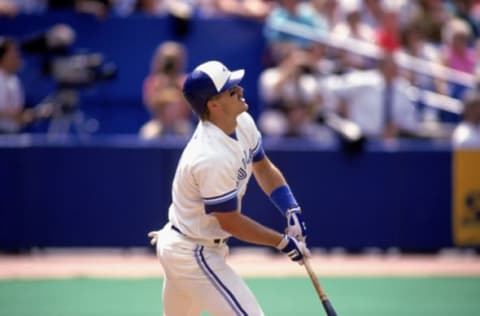
August 27th, 1992: Blue Jays trade Jeff Kent and Ryan Thompson for David Cone
When evaluating the Blue Jays exchange of Jeff Kent to the Mets and a player to be named later, outfielder Ryan Thompson, for David Cone, it can be looked at two different ways. Value wise it was a terrible trade for the Jays as they shipped out a borderline (and still potential) Hall of Famer at a young age for a rental, albeit a good one.
That same rental went on to help the club capture its first World Series title, pitching 22 1/3 innings with an ERA of 3.26 in the postseason and the Jays going 3-1 in his starts including the World Series clinching game 6. The point of making a move for a player on an expiring contract is to bolster your lineup to make a run in October, but also to get the player at a cheaper cost due to his looming free agency. Thankfully this somewhat panned out for the Jays as Cone did indeed help them win a championship but signed that offseason in Kansas City, but they also gave up a young star in the making.
The following season as a 25-year-old in his first season with the Mets, the worst team in the MLB that year, Kent was one of the team’s top contributors slashing .270/.320/.446 with 21 home runs and 80 RBI’s.
Looking at this trade value wise for both teams, Cone’s value with the Blue Jays was 0.9 WAR while Kent’s with the Mets was 7.6 and 3.5 for Thomson, a combined 10.9 WAR.
But it wasn’t Kent’s time with the Mets that had Jays fans kicking themselves over this trade, it was his following 12 years playing with the Giants, Astros and, Dodgers. He was the NL MVP in 2000 with the Giants and appeared in five All-Star Games to go along four Silver Slugger Awards. His WAR of 46.8 during those 12 seasons was the 19th best in all of baseball.
Was it worth a few months from a true ace accompanied by a ring for a player who will either enter the hall or ride out all ten years on the ballot, with just four years remaining to receive the 75 percent needed? It takes a special player to even come that close and the Blue Jays could have seen those accomplishments happen in Toronto if they had been thinking long-term instead of short-term. The short-term results weren’t all that bad either, though.
Jays Journal Contributor: Cam Black-Araujo
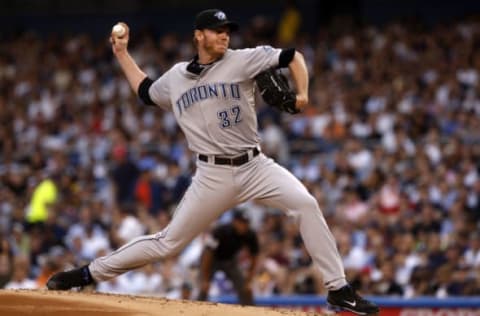
December 16th, 2009: Blue Jays trade Roy Halladay for Travis d’Arnaud, Kyle Drabek and Michael Taylor
One of the biggest trades in franchise history saw their soon to be Hall of Famer, Roy Halladay, traded to the Philadelphia Phillies.
It was a different situation in that Halladay more or less picked where he would go. The Blue Jays extended him the courtesy of letting them know where he’d like to end up, and it also helped with their trade negotiations when the acquiring team knew he would re-up there after his current deal with the Jays had expired.
At the time it looked like a promising return, but unfortunately, it’s worked out to be anything but. The Blue Jays received Kyle Drabek, Travis d’Arnaud, and Michael Taylor in return, all promising minor leaguers in the Philadelphia system at the time. The Blue Jays more or less immediately flipped Taylor to the A’s for a first baseman named Brett Wallace, who also had decent prospect rankings at the time.
Sticking with the Wallace trade train here, he was eventually swapped in exchange for Anthony Gose, who played a few seasons in Toronto between the big leagues and Triple-A Buffalo. Gose then eventually began the man who was swapped for Devon Travis, who is the only remaining asset from that first major trade that is still in the organization.
Going back to the original haul for Halladay, d’Arnaud was famously used in the trade with the New York Mets that brought back R.A. Dickey. d’Arnaud was one of the most highly rated catching prospects at the time but hasn’t developed into the star that many thought he would be, mostly battling injuries. If the trade had been centred around him then people likely wouldn’t lament the Mets deal so much, but unfortunately, Noah Syndergaard went with him as well, and we all know how that worked out.
Lastly, what looked to be the prize of the return was Kyle Drabek, son of former Pirates’ pitcher Doug Drabek. He had all the tools to be a top of the rotation starter, but unfortunately, a couple of Tommy John surgeries and a hold of other injury problems cut his career short of it’s potential. He did get a few chances in Toronto but ended up finishing with a career as a Blue Jay with an 8-15 record, posting a 5.26 ERA and a 1.698 WHIP in 30 starts and 43 total appearances.
While Dickey’s contribution was underrated while he was in Toronto, and Devon Travis could still salvage his career and return to the .300 hitter potential he flashed a few years ago, you have to consider the return for Roy Halladay to be pretty light. You could consider the trade tree to be a decent one if the Blue Jays had ended up with Travis and Dickey at the end of things, but you have to remember that Syndergaard went too. As bad as the return was for Halladay on its own, that’s what makes it even worse.
Jays Journal Expert: Chris Henderson
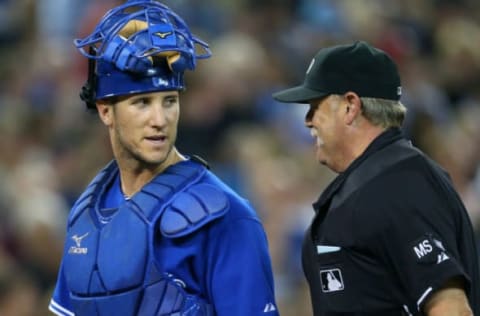
November 03rd, 2012: Blue Jays trade Yan Gomes and Mike Aviles for Esmil Rogers
Perhaps underratedly so, the Blue Jays’ decision to trade away catcher Yan Gomes in November 2012 is one of the worst trades of the decade for the franchise.
Though he only managed an OPS of .631 in his lone season with the club, he soon turned out to be an incredibly valuable asset for his new team, the Cleveland Indians, who only gave up hurler Esmil Rogers (who would pitch to an ERA of 4.77 the following year in Toronto) to get him.
In 2014, a year after joining the Indians, Gomes, 26 at the time, won a Silver Slugger award and slashed a solid .278/.313/.472 with 21 homers. Over the next three seasons, all with Cleveland on a reasonably priced deal, he would post an OPS of .643 and added 35 homers, 135 RBI, 48 doubles and 103 runs in 274 games.
His 2018 season, which brought him his first career All-Star nod, saw him smash 16 home runs and drive in 48 while slashing .266/.313/.449.
Now a member of the Washington Nationals, Gomes, who spent no more than three years in the Blue Jays system, is a more discrete, yet still disappointing, example of how trading away young assets can come back to bite an organization. Though he didn’t appear to have much promise at the time (having only been drafted in the 10th round), he soon turned into one of the most dependable catchers in the American League.
An unassumingly productive backstop, Gomes is predicted by Fangraphs’ Steamer system to slash .241/.295/.408 and put up a wRC+ of 86 in 2019 while adding 10 home runs and 34 RBI to his totals. Since being traded to Cleveland, he’s been worth a WAR of 11.8.
Jays Journal Contributor: Hayden Godfrey
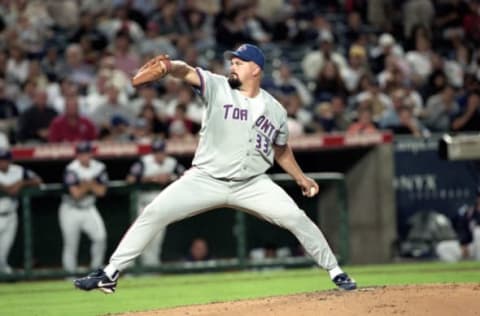
January 14th, 2001: Blue Jays trade David Wells and Matt DeWitt for Mike Williams, Kevin Beirne, Brian Simmons, and Mike Sirotka.
The Blue Jays dealt David Wells after a career-high campaign in 2000 where the hurler went 20-8 with a 4.11 and a 4.8 WAR in 35 starts. The main piece coming back from the White Sox in the deal was Mike Sirotka who may have been damaged goods at the time of the deal.
Sirotka was coming off a successful season of his own going 15-10 with a 3.79 earned run average and a 4.0 WAR in 32 starts. The hurler would endure a pair of shoulder surgeries and never pitch in the majors again, however, the Blue Jays still had to eat the $6.6 million left owing to Sirotka.
Thankfully, Wells would only spend one season on the south-side and was a shell of his former self. Boomer would go 5-7 with an inflated 4.47 earned run average in 16 starts before walking as a free agent at the conclusion of the 2001 season.
The Commissioner’s office denied the Blue Jays claim that Sirotka was injured at the time of the trade and the rest is history. None of the other players in the trade became factors at the MLB level.
Blue Jays Expert: Clayton Richer
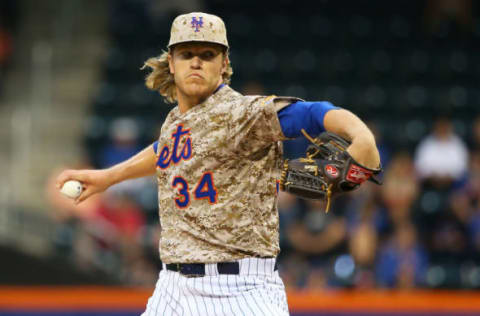
December 17th, 2012: Blue Jays trade Noah Syndergaard, Wuilmer Becerra, John Buck and Travis d’Arnaud for R.A. Dickey, Mike Nickeas and Josh Thole
When looking back at some of the stinkers in trades the Blue Jays have made over the years, the one that comes immediately to mind for me was the 2012 trade that saw the New York Mets trade CY Young winner R.A. Dickey along with catchers Josh Thole and Mike Nickeas in exchange for promising prospects Travis d’Arnaud, pitcher Noah Syndergaard and reliable backup catcher that we just received from the Marlins, John Buck.
At the time, I can understand Alex Anthopoulos’ thinking, let’s get a Cy Young winner in here to lead our team to the promised land, especially after the blockbuster with the Marlins. But man, looking back at this deal today, it stinks worse than a skunk smoking a joint at a sewage dump.
For starters, we had to take on Josh Thole as our catcher specifically for Dickey, and let’s be honest, that man thankfully was not an everyday catcher but when comparing his numbers to what d’Arnaud is becoming (minus last season because of his Tommy John surgery) you can easily see how the Mets won just on that trade alone.
Now the real stinker! We literally gave up Noah Syndergaard for R.A. Dickey, a young up and comer for a pitcher who was at the tail end of his career, who also needed Thole because nobody else was able to catch a knuckleballer (Poor Martin did try).
Syndergaard has now gone on to become the ACE for the Mets, came in fourth place for the ROY, pitched in the All-Star game in 2016 along with coming in 8th in voting for the CY Young and 19th for the NL MVP. Looking below, it really shows exactly what we gave up and could have had. I have not been a fan of Anthopoulos’ for quite some time and it’s deals like this that deserve to be dropped off at the city dump.
R.A. Dickey vs Noah Syndergaard Regular Season (using the two seasons the Jays made the post season) pic.twitter.com/NvJK6jU6tm
— Marc Tremblay (@93TremblayMarc) January 16, 2019
Finally, let’s take into consideration when you look at the postseason records, Syndergaard was much more valuable to the Mets then Dickey was to the Jays, in fact, we did not even use Dickey in our 2016 post season rotation.
R.A. Dickey vs Noah Syndergaard Post Season pic.twitter.com/aSYrlDzbqC
— Marc Tremblay (@93TremblayMarc) January 16, 2019
Next. Blue Jays All-Time WAR Leaders- Position Players. dark
Looking back at this trade, with the money that was also spent to extend Dickey’s contract this was a bad move all around. In hindsight, if we never made this deal, could you imagine going into the postseason with a starting rotation of Syndergaard, Price, Stroman, and Estrada or Sanchez. Things that make you go hmmmm.
Jays Journal Contributor: Marc Tremblay